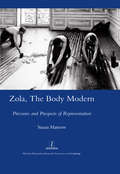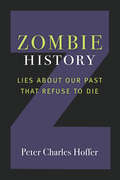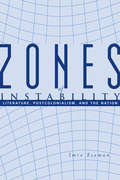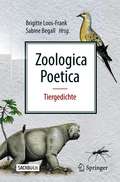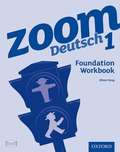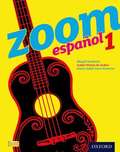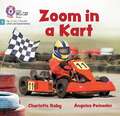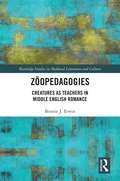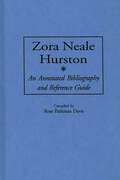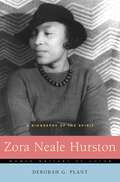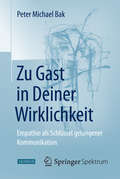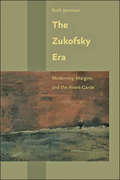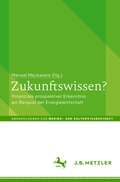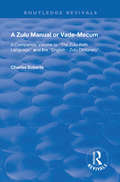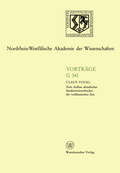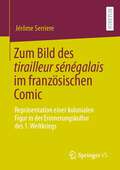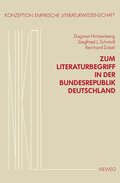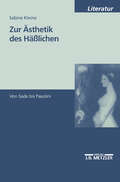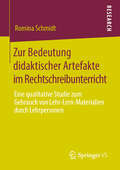- Table View
- List View
Zola, The Body Modern: Pressures and Prospects of Representation
by Susan HarrowEmile Zola's reputation as a landmark European novelist is undisputed. His monumental achievement, the novel cycle Les Rougon-Macquart: Histoire sociale et naturelle d'une famille sous le Second Empire (1871-1893), fixed his status as a major writer in the naturalist tradition. Is there any more to be said? Susan Harrow answers boldly in the affirmative, challenging the commonplace view that Zola's writing is predictable, prolix and transparent (what Barthes called 'readerly', for which read 'tedious'). Harrow exposes the modernist and postmodernist strategies which surface in the Rougon-Macquart novels, and reveals Zola's innovatory representation of the body captured here at work, at war, at play, at rest, and in arresting abstraction. Informed by critical thought from Barthes and Deleuze to Michel de Certeau and Anthony Giddens, Zola, the Body Modern offers a model for how we can revitalize our understanding of the canonical nineteenth-century European novel, and learn to travel more flexibly between parameters of century, style and aesthetics.
Zola, The Body Modern: Pressures and Prospects of Representation
by Susan HarrowEmile Zola's reputation as a landmark European novelist is undisputed. His monumental achievement, the novel cycle Les Rougon-Macquart: Histoire sociale et naturelle d'une famille sous le Second Empire (1871-1893), fixed his status as a major writer in the naturalist tradition. Is there any more to be said? Susan Harrow answers boldly in the affirmative, challenging the commonplace view that Zola's writing is predictable, prolix and transparent (what Barthes called 'readerly', for which read 'tedious'). Harrow exposes the modernist and postmodernist strategies which surface in the Rougon-Macquart novels, and reveals Zola's innovatory representation of the body captured here at work, at war, at play, at rest, and in arresting abstraction. Informed by critical thought from Barthes and Deleuze to Michel de Certeau and Anthony Giddens, Zola, the Body Modern offers a model for how we can revitalize our understanding of the canonical nineteenth-century European novel, and learn to travel more flexibly between parameters of century, style and aesthetics.
Zombie History: Lies About Our Past that Refuse to Die
by Peter Charles HofferFake history is not a harmless mistake of fact or interpretation. It is a mistake that conceals prejudice; a mistake that discriminates against certain kinds of people; a mistake held despite a preponderance of evidence; a mistake that harms us. Fake history is like the Zombies we see in mass media, for the fake fact, like the fictional Zombie, lives by turning real events and people into monstrous perversions of fact and interpretation. Its pervasiveness reveals that prejudice remains its chief appeal to those who believe it. Its effect is insidious, because we cannot or will not destroy those mischievous lies. Zombie history is almost impossible to kill. Some Zombie history was and is political, a genre of what Hannah Arendt called “organizational lying” about the past. Its makers designed the Zombie to create a basis in the false past for particular discriminatory policies. Other history Zombies are cultural. They encapsulate and empower prejudice and stereotyping. Still other popular history Zombies do not look disfigured, but like Zombies walk among us without our realizing how devastating their impact can be. Zombie History argues that, whatever their purpose, whatever the venue in which they appear, history Zombies undermine the very foundations of disinterested study of the past.
The Zombie in Contemporary French Caribbean Fiction (Contemporary French and Francophone Cultures #90)
by Lucy SwansonBelieved to have emerged in the French Caribbean based on African spirit beliefs, the zombie represents not merely the walking dead, but also a walking embodiment of the region’s history and culture. In Haiti today, the zombie serves as an enduring memory of enslavement: it is defined as a reanimated body robbed of part of its soul, forced to work in sugarcane fields. In Martinique and Guadeloupe, the zombie takes the form of a shape-shifting evil spirit, and represents the dangers posed to the maroon or “freedom runner.” The Zombie in Contemporary French Caribbean Fiction is the first book-length study of the literary zombie in recent fiction from the region. It examines how this symbol of the enslaved (and of the evil spirits that threaten them) is used to represent and critique new socio-political situations in the Caribbean. It also offers a comprehensive and focused examination of the ways contemporary authors from Haiti and the French Antilles contribute to the global zombie imaginary, identifying four “avatars” of the zombie—the slave, the trauma victim, the horde, and the popular zombie—that appear frequently in fiction and anthropology, exploring how works by celebrated and popular authors reimagine these archetypes.
Zones of Instability: Literature, Postcolonialism, and the Nation
by Imre SzemanAttempts by writers and intellectuals in former colonies to create unique national cultures are often thwarted by a context of global modernity, which discourages particularity and uniqueness. In describing unstable social and political cultures, such "third-world intellectuals" often find themselves torn between the competing literary requirements of the "local" culture of the colony and the cosmopolitan, "world" culture introduced by Western civilization.In Zones of Instability, Imre Szeman examines the complex relationship between literature and politics by exploring the production of nationalist literature in the former British empire. Taking as his case studies the regions of the British Caribbean, Nigeria, and Canada, Szeman analyzes the work of authors for whom the idea of the"nation" and literature are inexorably entwined, such as Chinua Achebe, Wole Soyinka, C.L.R. James, Frantz Fanon, and V.S. Naipaul. Szeman focuses on literature created in the two decades after World War II, decades in which the future prospects for many colonies went from extreme political optimism to extreme political disappointment. He finds that the "nation" can be read as that space in which literature is thought to be able to conjoin two things that history has separated—the writer and the people.
Zoologica Poetica: Tiergedichte
by Kai R. CasparDieses Buch richtet sich an Menschen, die Tiere und Gedichte lieben. Die Gedichtauswahl umfasst sowohl Werke namhafter Lyrikerinnen und Lyriker als auch weniger bekannte Dichtung und bislang unveröffentlichte Werke. Bei den rund 80 Gedichten stehen die zoologischen Aspekte im Vordergrund. Die Herausgeberinnen des vorliegenden Bandes, beide Zoologie-Professorinnen, haben viele der Gedichte mit kurzen erläuternden Anmerkungen zu zoologischen Details versehen, die zum inhaltlichen Verständnis beitragen. Den Leserinnen und Lesern wird somit ganz nebenbei Hintergrundwissen vermittelt, ohne ein weiteres Lehrbuch zur Hand nehmen zu müssen. Dabei nehmen die Herausgeberinnen oftmals Bezug auf die systematische Stellung des Tiers oder der Tiergruppe und klären etwa biologische, häufig auch parasitologische Zusammenhänge.
Zoom Deutsch. 1 Foundation Workbook (PDF)
by Vincent Everett Oliver GrayZoom Deutsch is an inspiring two-part German course offering fresh, exciting material and a fully-integrated video drama for the full ability range at Grades 6-9. There is a clear route through for students following both two-year and three-year courses so students and teachers know exactlyhow much material needs to be covered. Zoom Deutsch delivers the revised Grade 6-8 Programme of Study, PLTS and the Renewed Framework. The Zoom Deutsch course has a full suite of differentiated resources to support your needs: Student Books, Teacher Books, Foundation and Higher Workbooks, Audio CDs, Interactive OxBox CD-ROM and Assessment OxBox CD-ROM. This Zoom Deutsch 1 Foundation Workbook is full of extra listening, reading, writing and speaking material to reinforce and support the grammar, topics and skills learnt in the Student Book. It is ideal for homework and further practice either during or outside of lesson time. 9780199128105
Zoom Español, Level 1 (PDF)
by Isabel Alonso de Sudea María Isabel Isern Vivancos Abigail HardwickZoom espanol is an inspiring two-part Spanish course offering fresh, exciting material and a fully-integrated video drama for the full ability range at Grades 6-8. There is a clear route through for students following both two-year and three-year courses so students and teachers know exactlyhow much material needs to be covered. Zoom espanol delivers the revised Grade 6-8 Programme of Study, PLTS and the Renewed Framework. The Zoom espanol course has a full suite of differentiated resources to support your needs: Student Books, Teacher Books, Foundation and Higher Workbooks, Audio CDs, Interactive OxBox CD-ROM and Assessment OxBox CD-ROM. The Zoom espanol 1 Student Book is full of inspiring activities to suit all learner types. Each unit links to a video clip and video-blog of four teenagers from Barcelona providing students with a real insight into Spanish-speaking people and their life. As well as plenty of engaging activities tosupport listening, reading, speaking and writing there are also pages in every unit dedicated to grammar, study skills and pronunciation support. Further cultural reading material is provided for every unit so that students can learn about life in Spain and Spanish-speaking countries.
Zöopedagogies: Creatures as Teachers in Middle English Romance
by Bonnie J. ErwinThe human protagonists of medieval romance are works in progress. They are learners, taught by an unexpected set of teachers: non-human animals including horses, hawks, lions, and the various quarry of the hunt. These "creature teachers" show humans how to be more perfectly human—how to love, fight, survive, and live according to medieval culture’s highest ideals. Zöopedagogies explores the pedagogical role of animals in medieval romance, a genre whose fantastical elements enable animal characters to behave in ways inspired by, but not limited to their real-world actions. Situated at the intersection of animal studies and medieval studies, Zöopedagogies claims medieval roots for posthumanism by telling a new story about the role of animals in constructing Western culture. Bonnie Erwin brings together a diverse array of texts, including chivalric romances like Sir Gawain and the Green Knight and popular romances like Bevis of Hampton and Richard Coer de Lyon. She puts these into conversation with medieval texts on natural science, horsemanship, hawking, and hunting that inform the representation of creatures who teach. In so doing, she reveals a rich and nuanced sense of animals as participants in interspecies collaborative culture-making.
Zöopedagogies: Creatures as Teachers in Middle English Romance
by Bonnie J. ErwinThe human protagonists of medieval romance are works in progress. They are learners, taught by an unexpected set of teachers: non-human animals including horses, hawks, lions, and the various quarry of the hunt. These "creature teachers" show humans how to be more perfectly human—how to love, fight, survive, and live according to medieval culture’s highest ideals. Zöopedagogies explores the pedagogical role of animals in medieval romance, a genre whose fantastical elements enable animal characters to behave in ways inspired by, but not limited to their real-world actions. Situated at the intersection of animal studies and medieval studies, Zöopedagogies claims medieval roots for posthumanism by telling a new story about the role of animals in constructing Western culture. Bonnie Erwin brings together a diverse array of texts, including chivalric romances like Sir Gawain and the Green Knight and popular romances like Bevis of Hampton and Richard Coer de Lyon. She puts these into conversation with medieval texts on natural science, horsemanship, hawking, and hunting that inform the representation of creatures who teach. In so doing, she reveals a rich and nuanced sense of animals as participants in interspecies collaborative culture-making.
Zora Neale Hurston: An Annotated Bibliography and Reference Guide (Bibliographies and Indexes in Afro-American and African Studies)
by Rose P. DavisZora Neale Hurston (1891-1960) is one of 20th-century America's foremost fiction and folklore writers. Though she was criticized by some of her contemporaries, including Richard Wright and Ralph Ellison, her works are now frequently taught in literature courses and are widely admired for their style and substance. This reference book is a comprehensive guide to the large body of work written about her in the last 75 years. Included are annotated entries for books, dissertations, and theses written about Hurston's life and literary career. The volume also looks at hundreds of articles, book chapters, conference papers, reviews, children's books, and web sites. The bibliography additionally points the reader to guides and biographical sources and to anthologies where her works are collected. Finally, an exhaustive list of works by Hurston is provided, along with a catalog of the special collections where her manuscripts, correspondence, and ephemera are stored.Zora Neale Hurston (1891-1960) is one of 20th-century America's foremost fiction and folklore writers. One of the most important authors of the Harlem Renaissance and one of the first black anthropologists, she received little recognition during her lifetime. She was criticized by some of her contemporaries, including Richard Wright and Ralph Ellison, and her works were largely neglected until the early 1970s. Her works are now frequently taught in literature courses and are widely admired for their style and substance. Her anthropological study,IMules and Men (1935), is a pioneering examination of Voodoo and related folklore. As a novelist, she is best known as the author of Jonah's Gourd Vine (1934) and Their Eyes Were Watching God (1937). In addition, she was a prolific journalist who contributed to the most popular magazines and newspapers of her time.Though long neglected, Hurston has become firmly established in the literary canon, and scores of books and articles have been written about her. This reference book is a comprehensive guide to the large body of work written about her in the last 75 years. Included are annotated entries for books, dissertations, and theses written about Hurston's life and literary career. The volume also looks at hundreds of articles, book chapters, conference papers, reviews, children's books, and web sites. The bibliography additionally points the reader to guides and biographical sources and to anthologies where her works are collected. Finally, an exhaustive list of works by Hurston is provided, along with a catalog of the special collections where her manuscripts, correspondence, and ephemera are stored.
Zora Neale Hurston: A Biography of the Spirit (Women Writers of Color)
by Deborah G. PlantThis new biography takes into account the whole woman—not just the prolific author of such great works as Their Eyes Were Watching God , Moses, Man of the Mountain, Jonah's Gourd Vine, Mules and Men, as well as essays, folklore, short stories, and poetry—but the philosopher and the spiritual soul, examining how each is reflected in her career, fiction and nonfiction publications, social and political activity, and, ultimately, her death.When we ask what animated the woman who achieved all that she did, we must necessarily probe further. Not one of the other existing biographies discusses or analyzes Hurston's spirituality in any sustained sense, even though this spirituality played a significant role in her life and works. As author Deborah G. Plant shows, Zora Neale Hurston's ability to achieve and to endure all she did came from the courage of her convictions—a belief in self that was profoundly centered and anchored in spirituality.
Zu Gast in Deiner Wirklichkeit: Empathie als Schlüssel gelungener Kommunikation
by Peter Michael BakMit Scharfsinn, Humor und auf der Basis neuer wissenschaftlicher Erkenntnisse wird in diesem Sachbuch das alte Thema Kommunikation ganz neu beleuchtet. Das Thema Empathie steht dabei als Voraussetzung erfolgreicher Kommunikation im Mittelpunkt. Was aber ist Empathie ganz konkret? Wie funktioniert sie? Können wir den anderen wirklich verstehen? Wie können wir überhaupt empathisch sein? Gibt es Empathie auch im Internet? Wie hängen Empathie und Moral zusammen? Wie entstehen Konflikte und warum führt Empathie zur Selbsterkenntnis? Psychologieprofessor Peter Michael Bak gibt anhand zahlreicher Beispiele und auf der Grundlage aktueller psychologischer Forschungsergebnisse anregende und teilweise überraschende Antworten auf diese Fragen. Das Buch setzt dabei keinerlei Vor- oder Fachwissen voraus, sondern wendet sich an alle interessierten Leserinnen und Leser, die wissen möchten, warum es überhaupt Missverständnisse gibt und warum das Miteinander reden manchmal so schwierig sein kann. Den Leser erwarten dabei nicht nur interessante Einblicke zur gelingenden Kommunikation, sondern auch spannende Einsichten über sich selbst.
The Zukofsky Era: Modernity, Margins, and the Avant-Garde (Hopkins Studies in Modernism)
by Ruth JennisonInaugurated in 1931 by Louis Zukofsky, Objectivist poetry gave expression to the complex contours of culture and politics in America during the Great Depression. This study of Zukofsky and two others in the Objectivist constellation, George Oppen and Lorine Niedecker, elaborates the dialectic between the formal experimental features of their poetry and their progressive commitments to the radical potentials of modernity.Mixing textual analysis, archival research, and historiography, Ruth Jennison shows how Zukofsky, Oppen, and Niedecker braided their experiences as working-class Jews, political activists, and feminists into radical, canon-challenging poetic forms. Using the tools of critical geography, Jennison offers an account of the relationship between the uneven spatial landscapes of capitalism in crisis and the Objectivists’ paratactical textscapes. In a rethinking of the overall terms in which poetic modernism is described, she identifies and assesses the key characteristics of the Objectivist avant-garde, including its formal recognition of proliferating commodity cultures, its solidarity with global anticapitalist movements, and its imperative to develop poetics that nurtured revolutionary literacy. The resulting narrative is a historically sensitive, thorough, and innovative account of Objectivism’s Depression-era modernism.A rich analysis of American avant-garde poetic forms and politics, The Zukofsky Era convincingly situates Objectivist poetry as a politically radical movement comprising a crucial chapter in American literary history. Scholars and students of modernism will find much to discuss in Jennison’s theoretical study.
The Zukofsky Era: Modernity, Margins, and the Avant-Garde (Hopkins Studies in Modernism)
by Ruth JennisonInaugurated in 1931 by Louis Zukofsky, Objectivist poetry gave expression to the complex contours of culture and politics in America during the Great Depression. This study of Zukofsky and two others in the Objectivist constellation, George Oppen and Lorine Niedecker, elaborates the dialectic between the formal experimental features of their poetry and their progressive commitments to the radical potentials of modernity.Mixing textual analysis, archival research, and historiography, Ruth Jennison shows how Zukofsky, Oppen, and Niedecker braided their experiences as working-class Jews, political activists, and feminists into radical, canon-challenging poetic forms. Using the tools of critical geography, Jennison offers an account of the relationship between the uneven spatial landscapes of capitalism in crisis and the Objectivists’ paratactical textscapes. In a rethinking of the overall terms in which poetic modernism is described, she identifies and assesses the key characteristics of the Objectivist avant-garde, including its formal recognition of proliferating commodity cultures, its solidarity with global anticapitalist movements, and its imperative to develop poetics that nurtured revolutionary literacy. The resulting narrative is a historically sensitive, thorough, and innovative account of Objectivism’s Depression-era modernism.A rich analysis of American avant-garde poetic forms and politics, The Zukofsky Era convincingly situates Objectivist poetry as a politically radical movement comprising a crucial chapter in American literary history. Scholars and students of modernism will find much to discuss in Jennison’s theoretical study.
Zukunftswissen?: Potenziale prospektiver Erkenntnis am Beispiel der Energiewirtschaft (Abhandlungen zur Medien- und Kulturwissenschaft)
by Manuel MackasareVorstellungen von der Zukunft bestimmen das menschliche Handeln. In energiewirtschaftlichen Fragen sind solche Antizipationen besonders relevant: Staaten beschließen Förderprogramme, Unternehmen errichten Kraftwerke, Privatpersonen füllen ihre Öltanks oder ersetzen sie durch Wärmepumpen – stets mit Blick auf ein Morgen, der mitunter trügerisch ist. Kontrovers diskutiert wird, ob es ein Wissen von der Zukunft überhaupt geben und inwieweit es Gegenstand der Wissenschaft sein kann. Die Beiträge dieses Bandes untersuchen Möglichkeit, Methoden und Geltung von Zukunftsentwürfen aus philosophischer, historischer, sozial-, literatur- und medienwissenschaftlicher Perspektive.
A Zulu Manual or Vade-Mecum: A Companion Volume to ''The Zulu-Kafir Language'', And The '' English - Zulu Dictonary''. (Routledge Revivals)
by Charles RobertsPublished in 1900, this book provides a companion volume to the Zulu Kafir Language and the English Zulu Dictionary. Including a dictionary and examples of language structure and grammar, this book makes Zulu accessible to all levels of learner.
A Zulu Manual or Vade-Mecum: A Companion Volume to ''The Zulu-Kafir Language'', And The '' English - Zulu Dictonary''. (Routledge Revivals)
by Charles RobertsPublished in 1900, this book provides a companion volume to the Zulu Kafir Language and the English Zulu Dictionary. Including a dictionary and examples of language structure and grammar, this book makes Zulu accessible to all levels of learner.
Zum Aufbau altindischer Sanskritwörterbücher der vorklassischen Zeit (Nordrhein-Westfälische Akademie der Wissenschaften #341)
by Claus VogelZum Bild des tirailleur sénégalais im französischen Comic: Repräsentation einer kolonialen Figur in der Erinnerungskultur des 1. Weltkriegs
by Jérôme SerriereDie Ausgangsfrage dieser Untersuchung ist, wie sich eine Gesellschaft an den 1. Weltkrieg erinnert und inwiefern sich diese Erinnerung mit der Zeit wandelt. Das Phänomen eines solchen „kollektiven Gedächtnisses“ und die verschiedenen Konzepte von Halbwachs, Nora („lieux de mémoire“), Jan Assmann („kulturelles Gedächtnis“) und Aleida Assmann („Funktions- und Speichergedächtnis“ des kulturellen Gedächtnisses) bilden den theoretischen Rahmen der Arbeit.Das Untersuchungsmedium zur Erforschung der französischen Erinnerungskultur zum 1. Weltkrieg bilden Comics („bande dessinées“), ein in Frankreich etabliertes und nachgefragtes Medium. Im Fokus der Betrachtung steht die Rolle der sogenannten „tirailleurs sénégalais“ in der Erinnerungskultur und wie sich die Kolonialzeit auf ihre Wahrnehmung in der französischen Gesellschaft auswirkte. Unterschieden wird dabei zwischen Tirailleurs als Kolonialsoldaten und der Figur des Tirailleurs als Konstrukt einer vergangenen Kolonialzeit. Den Kern der Arbeit bildet die Analyse zweier ausgewählter Comics. Nach festgelegten Kriterien (Deskription, Authentizität, Darstellung, Beitrag zur Erinnerungskultur) wird hier die Darstellung der Tirailleurs im Comic mit dem Bild der Tirailleurs in der Erinnerungskultur und in der Kolonialzeit verglichen. In den Comics werden aus erinnerungskulturellen Randfiguren und historischen Statisten Hauptfiguren des 1. Weltkriegs und selbstbestimmte Protagonisten postkolonialen Ausmaßes.
Zum Literaturbegriff in der Bundesrepublik Deutschland (Konzeption Empirische Literaturwissenschaft #3/4)
by Dagmar HintzenbergZur Ästhetik des Häßlichen: Von Sade bis Pasolini
by Sabine KleineDer Band spannt einen Bogen von de Sade über die »Schwarze Romantik« bis zum französischen Surrealismus und Pasolinis "Salò o le 120 giornate di Sodoma".
Zur Bedeutung didaktischer Artefakte im Rechtschreibunterricht: Eine qualitative Studie zum Gebrauch von Lehr-Lern-Materialien durch Lehrpersonen
by Romina SchmidtDidaktische Artefakte wie Schulbücher, Lernspiele und Tafelbilder sind wichtige „Mitspieler“ im grundschulischen Rechtschreibunterricht. Die vorliegende Studie von Romina Schmidt untersucht mit Strategien der Grounded-Theory-Methodologie, wie diese am alltäglichen Rechtschreibunterricht beteiligt sind und welcher Rechtschreibunterricht aus ihrer Beteiligung hervorgeht. Das Ergebnis der Untersuchungen sind Bausteine einer empirischen Theorie, die Gebrauchssituationen als „zweistimmiges Zeigen“ beschreibbar machen. Die Analyse verweist u.a. darauf, dass der derzeitige Materialgebrauch bestehende Ungleichheitsordnungen im Rechtschreibunterricht stabilisiert.
